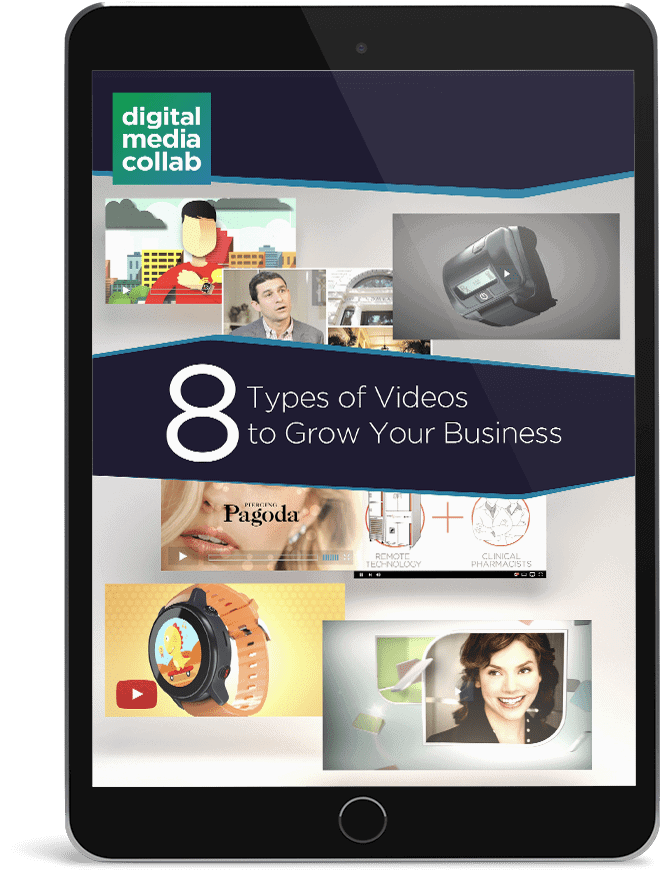If you are reading this, you probably realize that video marketing is strong and you are ready to dive in. But first, you need to know and figure out who your intended audience is. This is also a crucial step; if you create a video without a specific audience in mind, it’s much more likely to be a flop. Those who are meant to watch it won’t, and those who do watch it won’t convert. So, how do you know who your target audience is?
Things to consider with Video Marketing Strategies:
On average, video content is shared 1200 percent more than text and image posts combined – making it the perfect pursuit for businesses looking to increase their organic reach.
Video is projected to represent 82% of all internet traffic When done right, the return on investment of video marketing can be huge.
51% of marketing professionals around the world said that as far as content goes, video has the best ROI.
Marketers who use video increase revenue 49% faster than marketers who don’t use it, and social video produces 1,200% more shares than images and text combined.
Understand your target customers
The key is developing your buyer’s persona. If you already have one — great! Creating a buyer’s persona (or a few) is usually done when a company is developing its product or service offerings. Presumably, the people you want to buy your product are also the people you want to reach with your video.
With your buyer’s persona mapped out, you’ll know exactly who your target audience is. Keep in mind according to the statistics, 54% of users want to see more videos and different types of videos about their favorite brands or business.
What are the different types of marketing videos?
The popular types of videos content can be endless, however, business marketing videos can be grouped into different types of video marketing content:
Explainer Videos
What is an explainer video? Explainer videos provide information by explaining concepts related to products and services through animated visuals. They help customers understand complex ideas quickly and easily. The goal of this type of video is to educate consumers while entertaining them at the same time. Explainers let you share important messages quickly and effectively. Most people remember stories much longer than they remember numbers. Stories are memorable because they tell an interesting story.
How-to Videos
This kind of video provides instructions on how to perform certain tasks using visual aids like diagrams, animations, etc. It helps viewers learn new skills or master existing ones. How-to guides make learning easier because they break down complicated subjects into simple
Entertaining Videos
This kind of video is usually designed to make the consumer laugh. Not every single person will enjoy watching these kinds of videos. For example, some may find them too childish whereas others might think they’re boring. In addition, there’s no guarantee that everyone will appreciate your brand’s humor. However, most companies tend to produce funny videos since they believe that audiences respond well to entertainment- and when you get it right, they tend to go viral.
Educational/Informative Videos
An educational video aims to inform rather than entertain. These videos teach consumers something new or give them valuable tips and tricks. Educational videos often include facts, figures, data, and other statistical information. These videos teach something useful.
Testimonial Videos
Testimonials are very powerful tools for businesses. This type of video allows potential clients to hear first hand from real satisfied customers what working with your company means to them personally. A customer satisfaction survey should always accompany any testimonials so that you can measure whether your efforts were successful.
Product Videos or Product Demos
Product videos demonstrate the features and benefits of your product or service. If you don’t show off your product then nobody knows what it does. And without knowing what it does, you won’t sell it. So, why not use video as part of your sales process?
People love seeing things being used. When we watch movies, we expect to see actors doing stuff with their hands. We expect to see cars driving around town. Why shouldn’t we expect to see our products do stuff?
Animated Videos with Graphic Elements
Animated videos can be better than a regular video. They have been around for years but only recently has technology advanced enough to allow us to create high quality animation. Today, anyone can create great looking cartoons and even better sounding music. But creating good animation takes skill and practice. Writing a great script will help get the precise point across to the viewer.
Promotional Video
Promotional videos are short videos created specifically to promote your business, products, or services. They are meant to attract attention and encourage people to visit your website, call up your business or purchase products and services. Some examples of promotional videos include:
1. An introduction about your business.
2. A demonstration of your product or service in action.
3. A promotion where you talk directly to the camera.
4. A presentation of your staff members.
The key to a Successful Video Marketing Strategy
To finalize your audience strategy, just make sure you have the following figured out:
Who your product or service is for — this will be your buyer’s persona.
What the purpose of your video is — this will be where they fall within the marketing funnel.
Where your target audience hangs out — this will inform how you distribute your video.
With these three questions answered, you’ll know not only who your target audience is, but how to reach them, as well.
Figure Out What Story You Want to Tell
Deciding what story you want your video to tell can be the most fun and the most difficult part. You’ll want to outline the following four elements, which serve as the basic framework of your story.
Protagonist with a goal – This person should align with your target demographic.
Conflict – This is your customer’s pain point.
Quest – This will be how you introduce your product or service.
Resolution – This is how your product or service solves the problem.
These elements of your story should take the viewer on a journey — one that should align with your brand mission.
Also, think about what emotion you want your story to impart on the viewer as you craft your story. Do you want them to laugh? Should they feel inspired or happy after watching your video? Whatever emotion you want your viewers to have, think about that as you write your script. Everything from the props and the location to the colors and the wardrobe will communicate this, so choose every detail wisely!
These elements of your story should take the viewer on a journey — one that should align with your brand mission.
Keep Creative Requirements in Mind
As you craft your story, keep in mind the people who will need to approve your video (your manager, your company’s founder, your marketing department, etc.) and the time it takes to implement their feedback. Sudden changes in scripting, messaging, goals, and more can throw your whole production off-kilter. But still, these changes are all too common. Take a look at our creative guide that’ll help you manage creative feedback from everyone on your team.
Always (Try to) Stick to Your Timeline
As you’re planning your entire production, from creative ideation to actual video distribution, you should have a timeline to stick to. You should actually have multiple — overall timeline, production timeline, distribution timeline, and more. Your timeline serves as your guiding light, keeping you aware of how much you’ve done and what’s left to do.
Timelines are crucial for every member of your team. Marketing might have their own timeline, production might have their own, and your social media department will have their own. Basically, be a good sport and keep everyone informed of schedules, changes, and completion dates.
Maintain a Realistic Budget and Realistic Goals
Cash rules all! Yes, creative planning and strategy are important, but let’s be real. Without the proper budget, it’s going to be difficult to get exactly what you want. Plan for the money and resources at your disposal. Plan what you’ll create or shoot in-house and what you may want to outsource to a production company. Plan what you can splurge on and what you may want to save on.
And always shop around, not just literally, but figuratively. Ask industry experts how much they charge for certain services (scripting, sound editing, social media distribution, etc.) and how much you might expect to pay if you hired a freelancer or full-time employee instead. Most agencies are more than happy to give you any information you might want, or guide you to others who can better help.
Certain videos and features might cost you more than others, too, so be sure you research this all before you settle on the type of video you want and how you’ll go about creating it. Keep in mind, from what we have seen in great videos these days is they do not need to be high-quality video with huge production costs to find potential customers.




